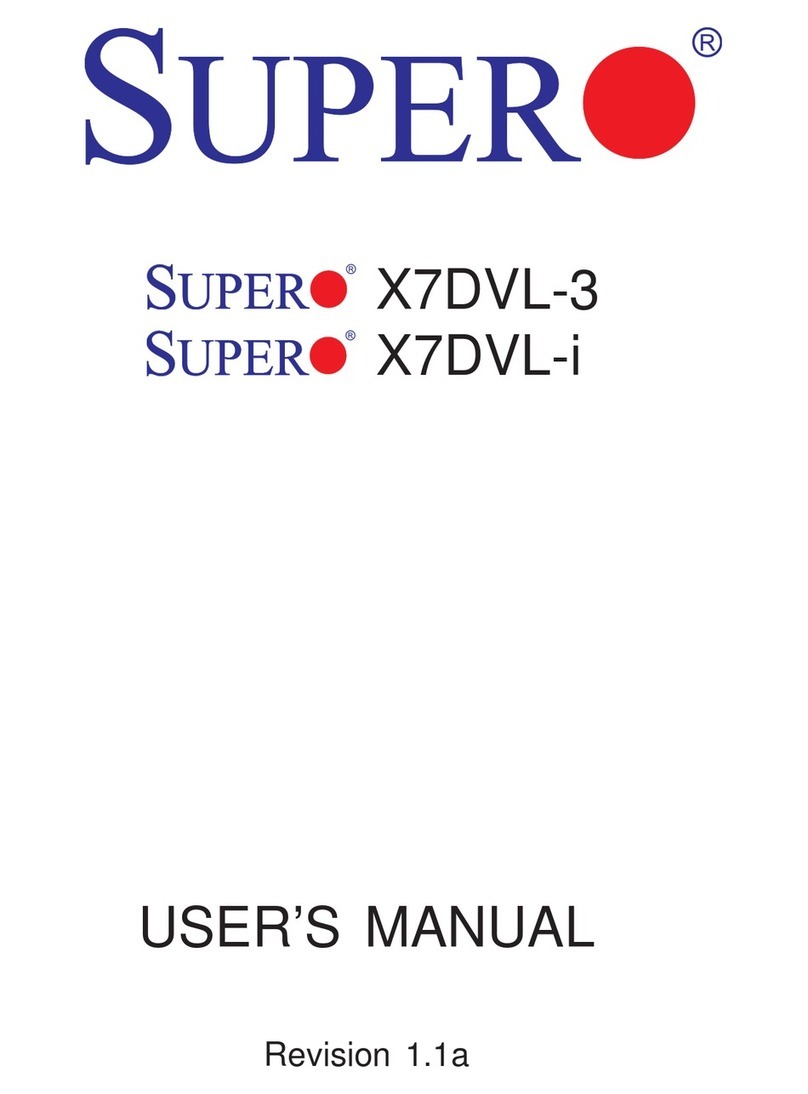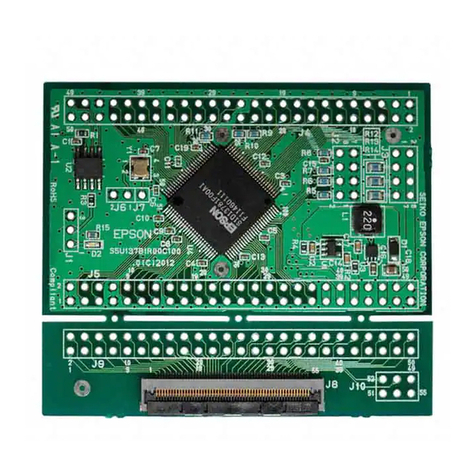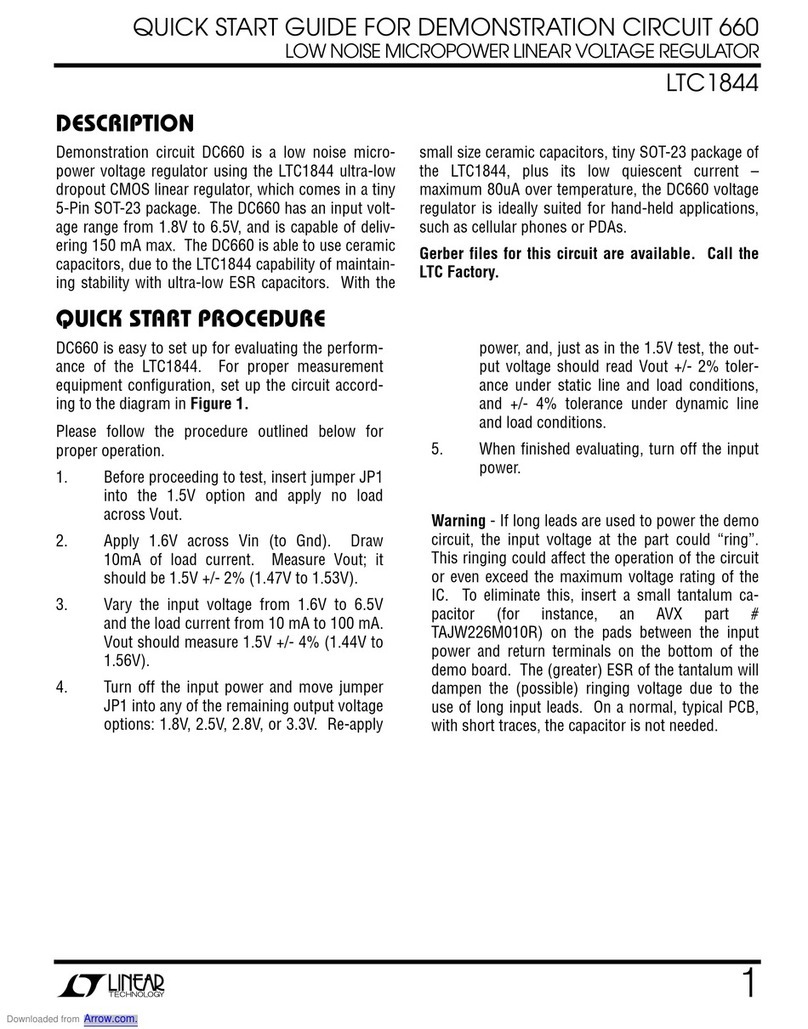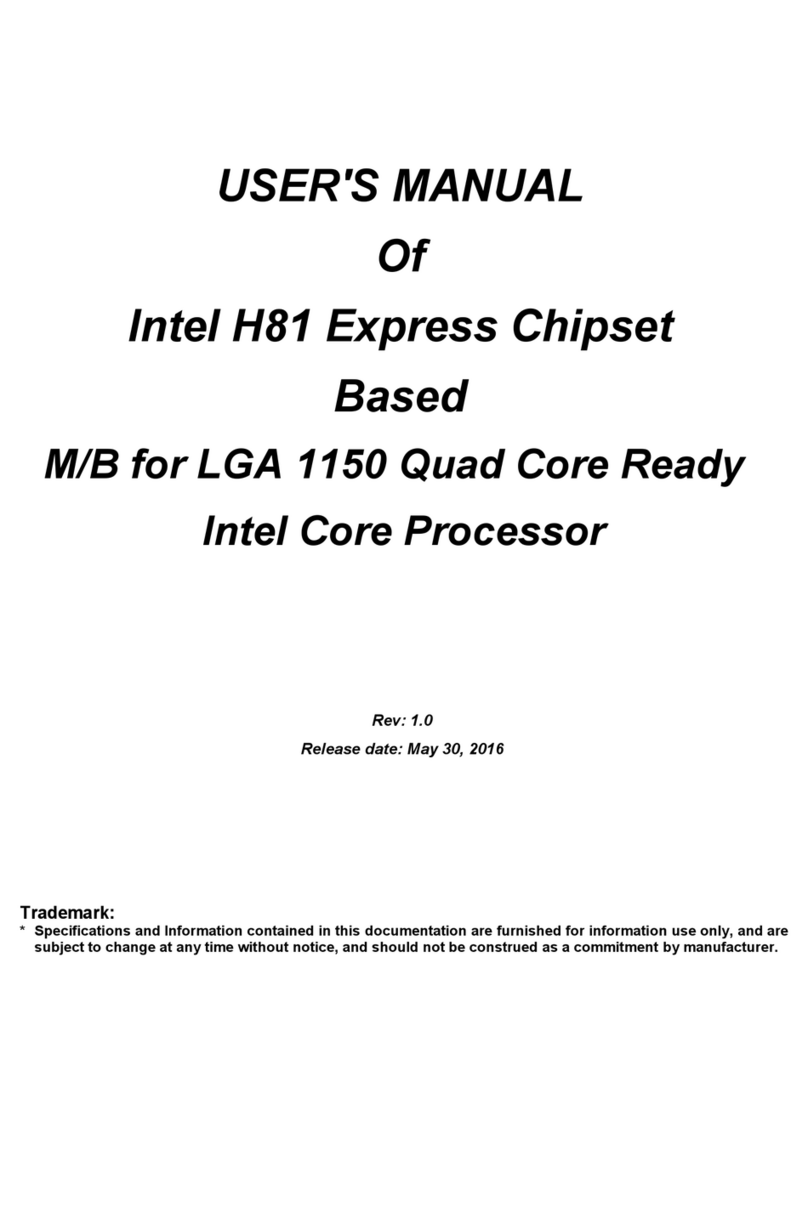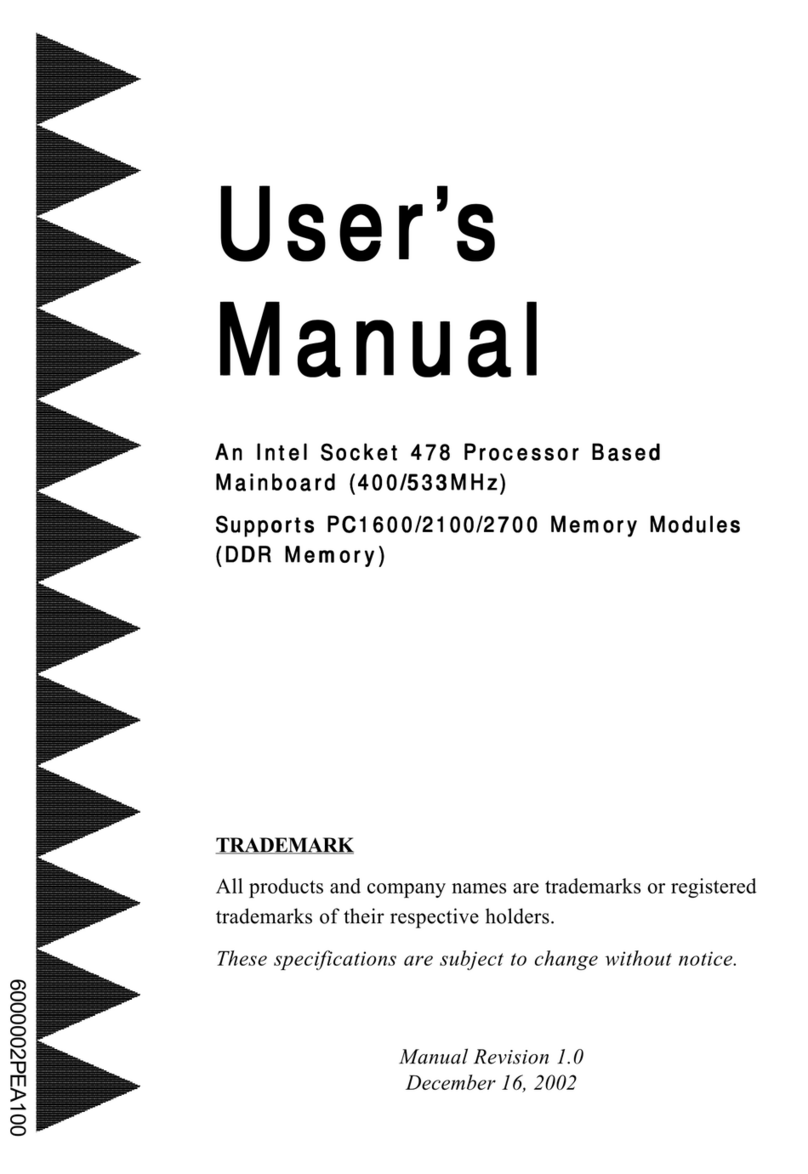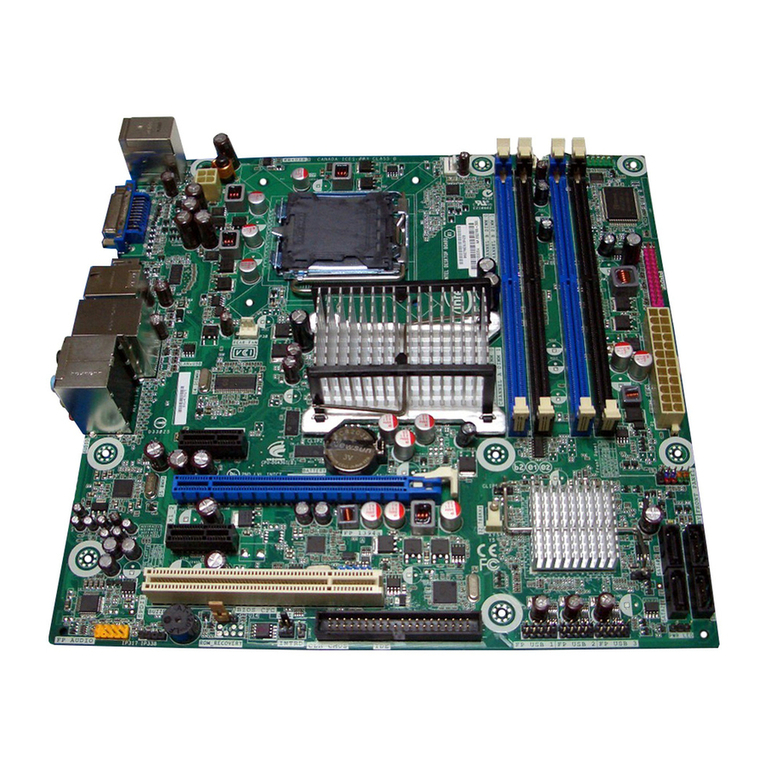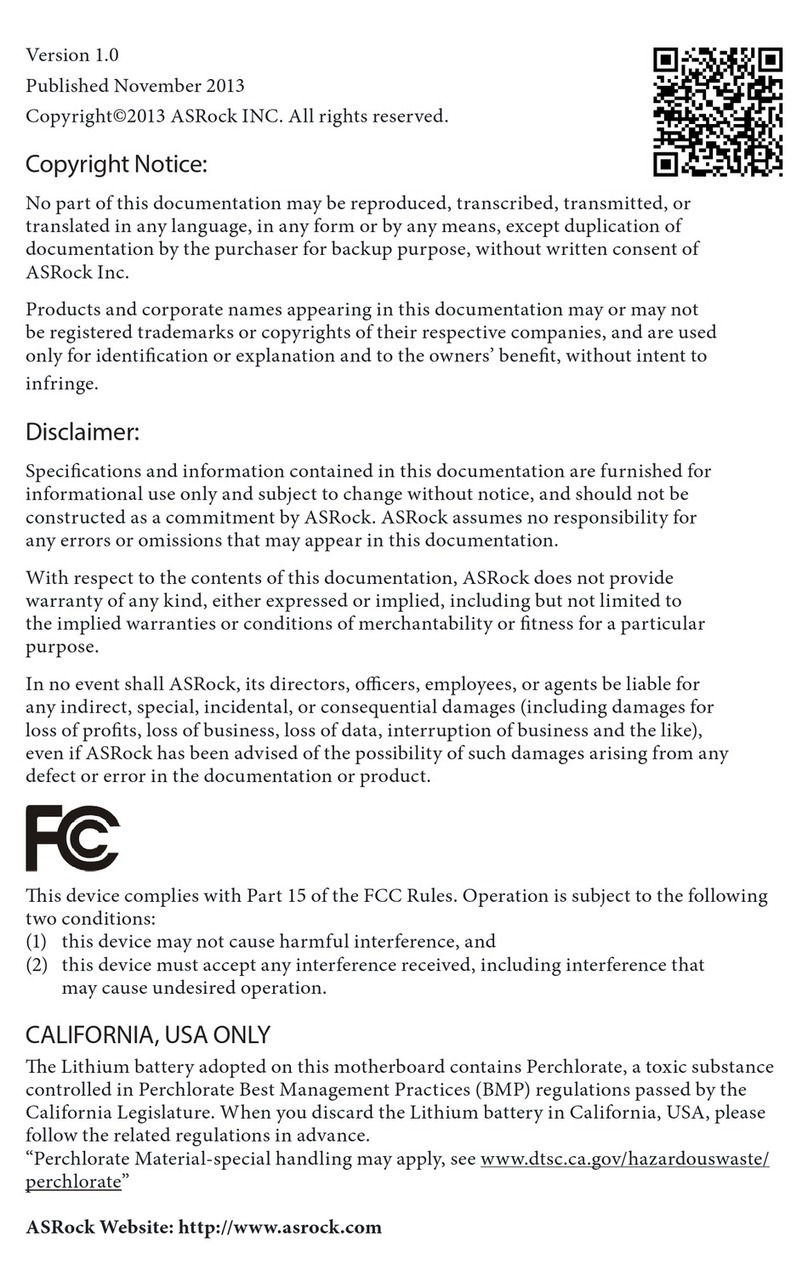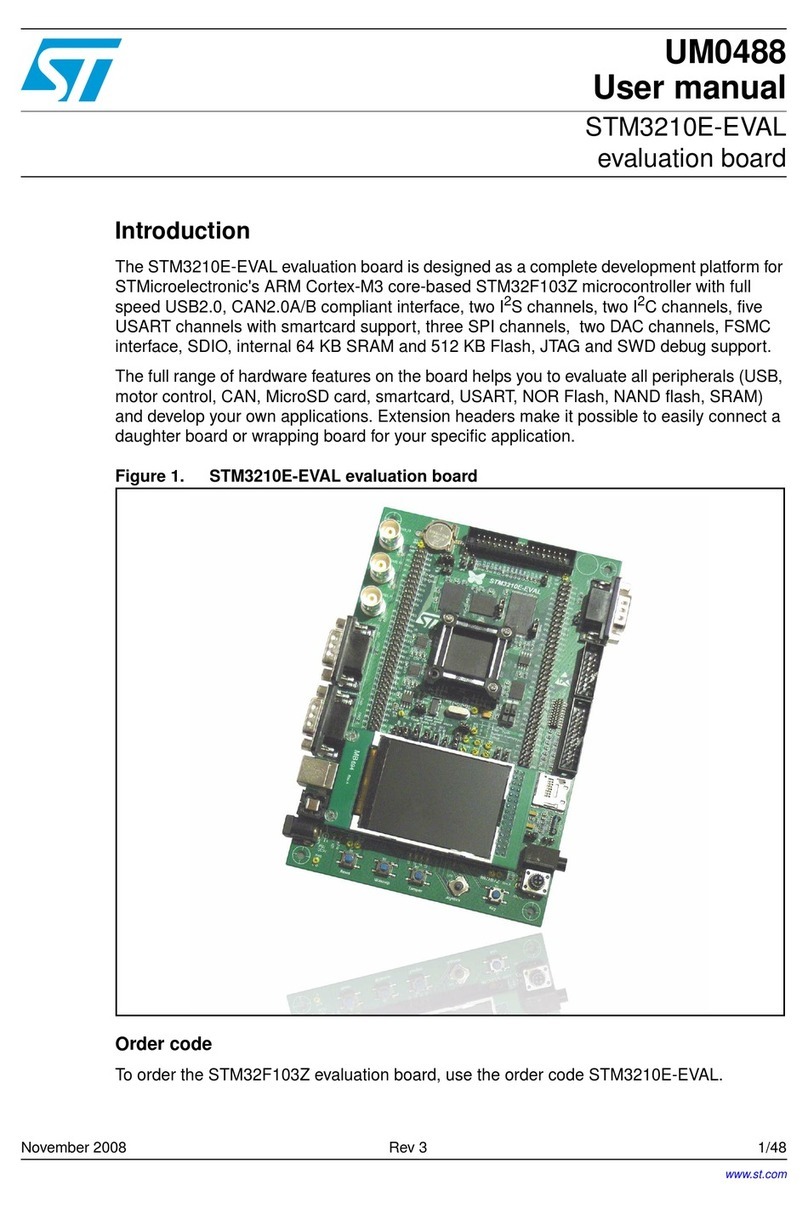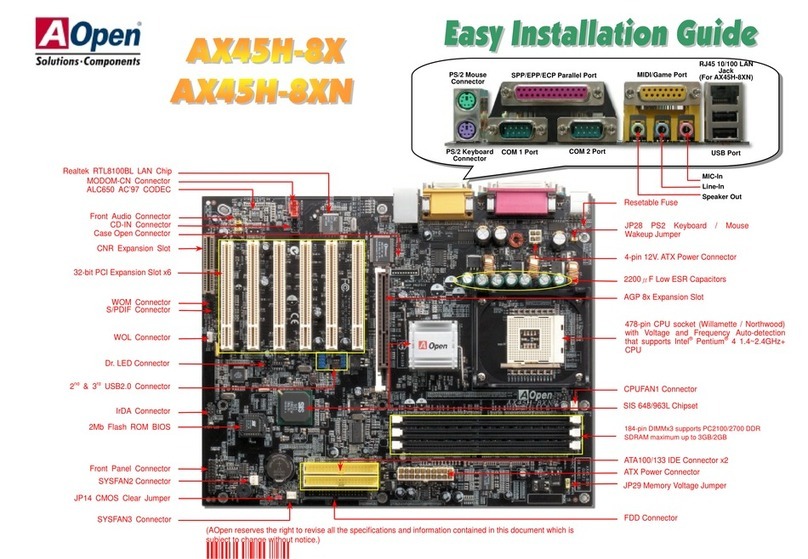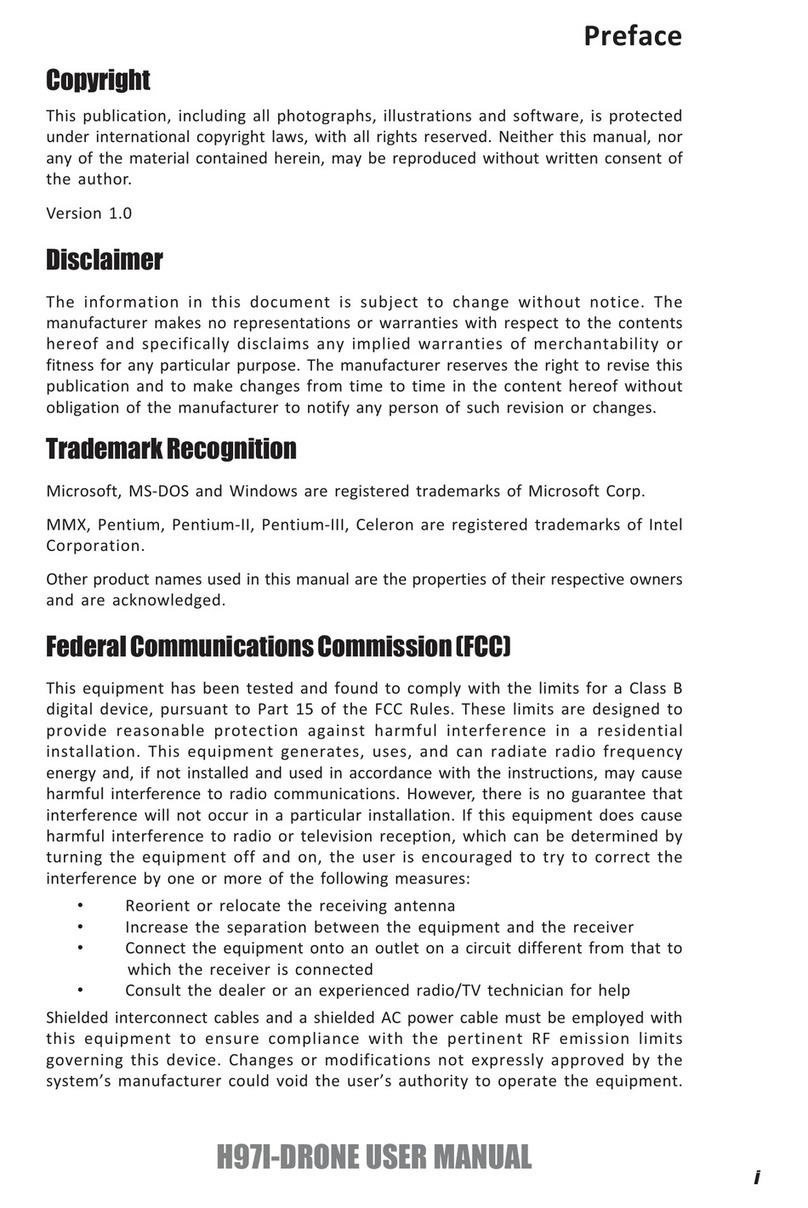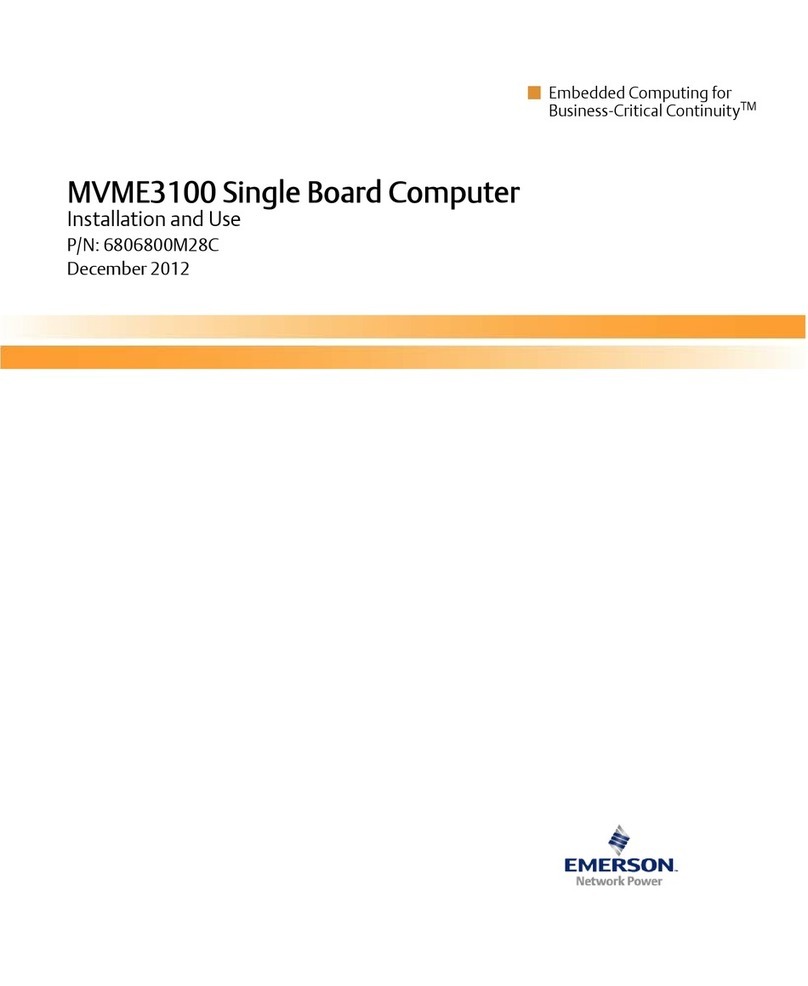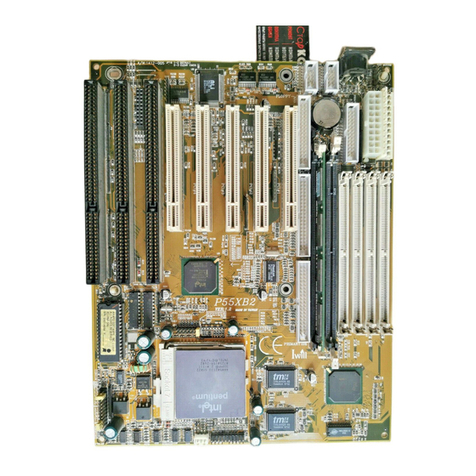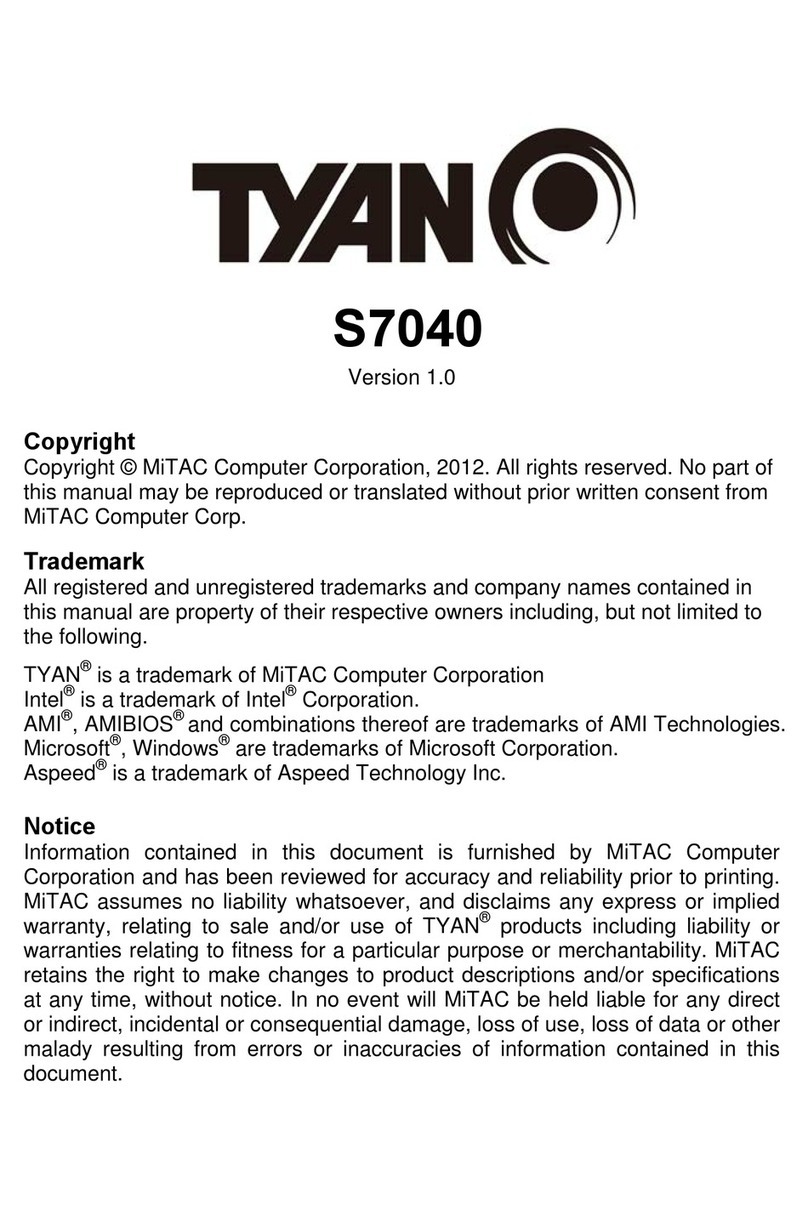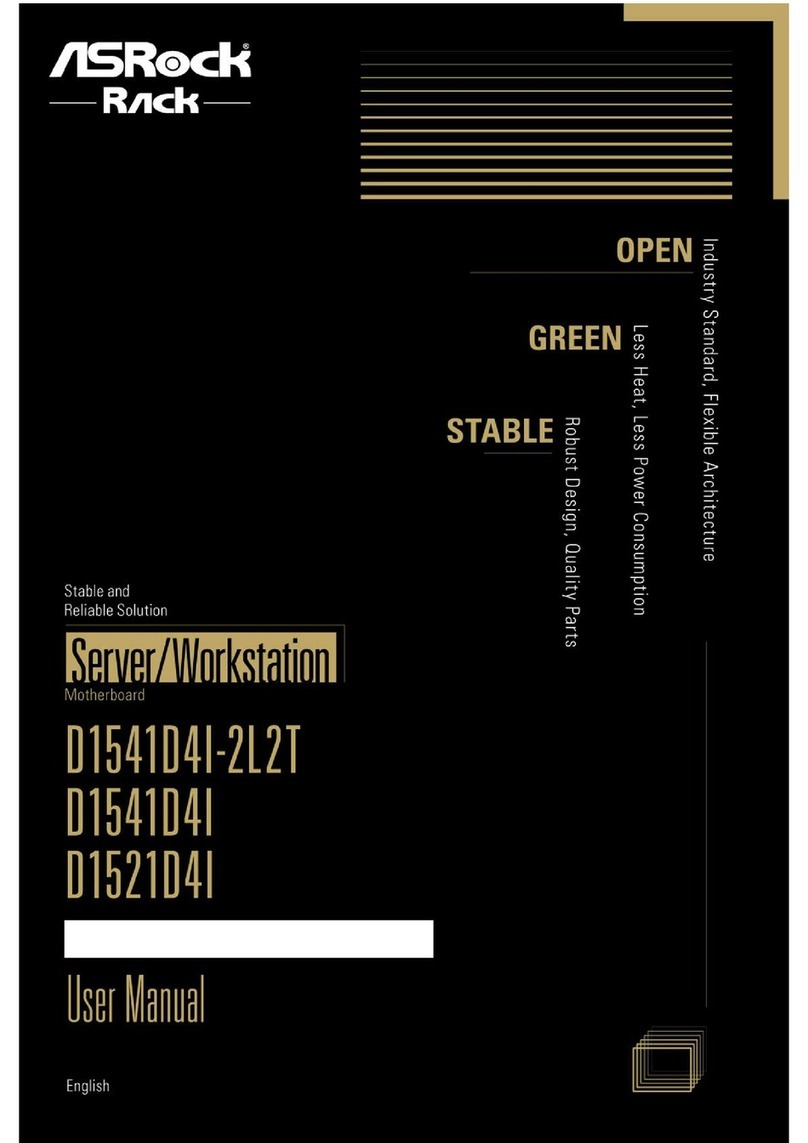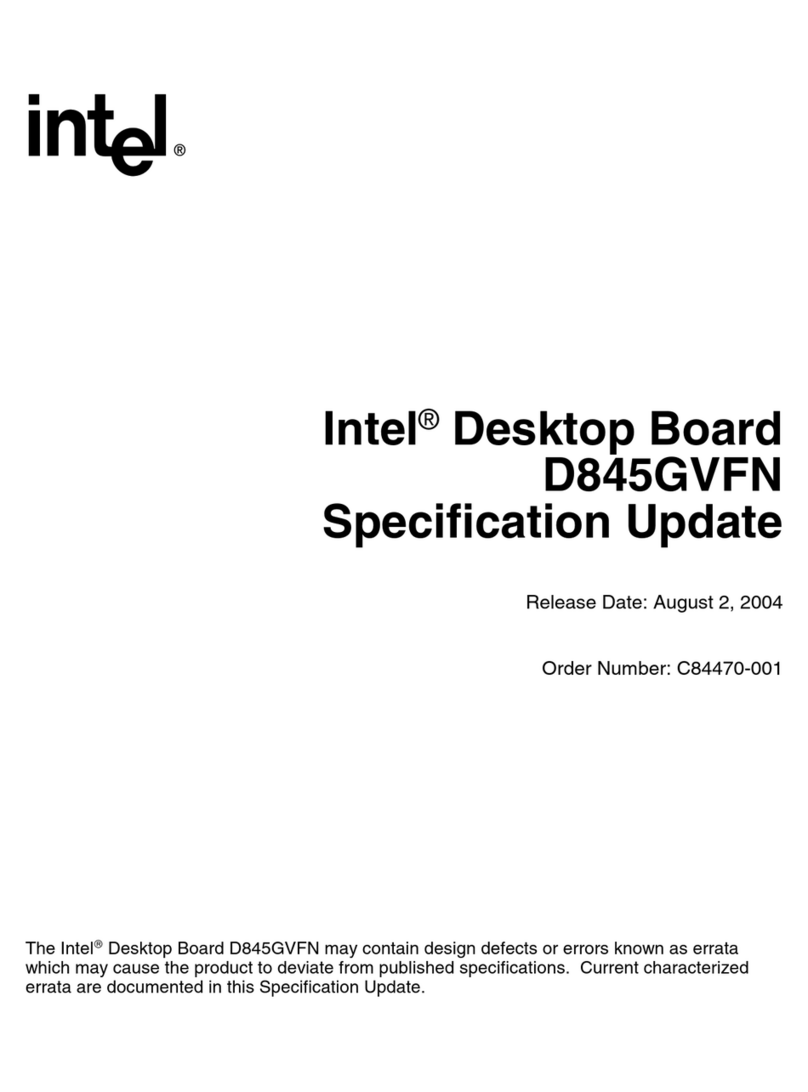NGX Technologies BlueBoard-LPC214X User manual

User Manual: BlueBoard-LPC214X
Revision 1.3
1
USER MANUAL
BlueBoard-LPC214X

User Manual: BlueBoard-LPC214X
Revision 1.3
2
Revision 1.3
Author: Ashwin Athani
or any questions, concerns, or issues submit them to ashwin@ngxtechnologies.com
NGX Technologies Pvt. Ltd. provides the enclosed product(s) under the following conditions:
This evaluation board/kit is intended for use for ENGINEERING DEVELOPMENT, DEMONSTRATION,
EDUCATION OR EVALUATION PURPOSES ONLY and is not considered by NGX Technologies Pvt. Ltd to be a
finished end-product fit for general consumer use. Persons handling the product(s) must have electronics
training and observe good engineering practice standards. As such, the goods being provided are not
intended to be complete in terms of required design-, marketing-, and/or manufacturing-related protective
considerations, including product safety and environmental measures typically found in end products that
incorporate such semiconductor components or circuit boards. This evaluation board/kit does not fall within
the scope of the European Union directives regarding electromagnetic compatibility, restricted substances
(RoHS), recycling (WEEE), CC, CE or UL, and therefore may not meet the technical requirements of these
directives or other related directives.
The user assumes all responsibility and liability for proper and safe handling of the goods. urther,
the user indemnifies NGX Technologies from all claims arising from the handling or use of the goods. Due to
the open construction of the product, it is the user’s responsibility to take any and all appropriate
precautions with regard to electrostatic discharge.
EXCEPT TO THE EXTENT O THE INDEMNITY SET ORTH ABOVE, NEITHER PARTY SHALL BE LIABLE TO
THE OTHER OR ANY INDIRECT, SPECIAL, INCIDENTAL, OR CONSEQUENTIAL DAMAGES.
NGX Technologies currently deals with a variety of customers for products, and therefore our
arrangement with the user is not exclusive. NGX Technologies assumes no liability for applications
assistance, customer product design, software performance, or infringement of patents or services
described herein.
Please read the User’s Guide and, specifically, the Warnings and Restrictions notice in the User’s
Guide prior to handling the product. This notice contains important safety information about temperatures
and voltages.
No license is granted under any patent right or other intellectual property right of NGX Technologies
covering or relating to any machine, process, or combination in which such NGX Technologies products or
services might be or are used.
Mailing Address:
#142, 1
st
loor, 1
st
‘C’ Cross,
6
th
‘B’ Main, Remco Layout,
Vijaynagar 2
nd
Stage
Bangalore
India – 560040

User Manual: BlueBoard-LPC214X
Revision 1.3
3
Change Log:
Revision 1 to Revision 1.1:
• Changed the product image
• Added a note in section 3.2.8 for the SD/MMC connector regarding the card fi e format
• Updated the ‘USB Virtua COM Port Insta ation for Windows XP’ section
Revision 1.1 to Revision 1.2:
• Added a ‘known issues’ section
Revision 1.2 to Revision 1.3
• The I2C EEPROM issue was reso ved, hence de eted it from known issues ist

User Manual: BlueBoard-LPC214X
Revision 1.3
4
Table of Contents
1
INTRODUCTION ............................................................................................................5
1.1
BLUEBOARD FEATURE .......................................................................................................5
2
GET GOING....................................................................................................................
2.1
Y TEM REQUIREMENT ......................................................................................................6
2.2
TARTING OFF..................................................................................................................6
2.2.1
Connecting the hardware .......................................................................6
2.2.2
Programming BlueBoard ........................................................................6
3
BLUEBOARD HARDWARE ...............................................................................................8
3.1
FUNCTIONAL OVERVIEW ......................................................................................................8
3.2
HARDWARE CONFIGURATION ...............................................................................................9
4
BLUEBOARD UTILITIES ...............................................................................................18
4.1
OVERVIEW .................................................................................................................... 18
4.2
TARTING OFF................................................................................................................ 18
5
TROUBLESHOOTING ....................................................................................................19
5.1
U B VIRTUAL COM PORT IN TALLATION FOR WINDOW XP ......................................................... 19
SCHEMATICS ...............................................................................................................22
7
SAMPLE APPLICATIONS ..............................................................................................23
8
KNOWN ISSUES...........................................................................................................24

User Manual: BlueBoard-LPC214X
Revision 1.3
5
1 INTRODUCTION
1.1 BlueBoard Features
BlueBoard-LPC214X is a evaluation board for LPC2148 ARM7TMDI based microcontroller. The
LPC2148 microcontroller has 512KB of internal flash and 32+8K RAM. Following are the salient
features of the board.
Dimensions: 114 X 127 mm2
Two ayer PCB (FR-4 materia )
Power:
Power supp y: DC 6.5V with power LED
On-board inear regu ators generate +3.3V/500mA and +5v/500mA from power supp y.
USB connector ( as a ternate power source).
Connectors:
Extension headers for a microcontro er pins.
RS232 connectors (2).
VGA connector.
PS/2 connector.
JTAG connector.
SD/MMC connector.
USB B-type connector with Link-LED.
A periphera configurab e via jumpers.
Other Periphera s:
256Kb I2C based EEPROM
Audio power amp ifier.
2 ine X 16 character LCD with back ight contro .
Configurab e for manua and automatic program down oad(ISP) via seria port.
8 contro ab e LEDs on SPI using 74HC595.

User Manual: BlueBoard-LPC214X
Revision 1.3
6
2 Get going
2.1 System Requirements
Windows XP
erial or Parallel port
U B port
2.2 Starting off
2.2.1 Connecting the hardware
After unpacking the BlueBoard connect a DC supply of 7.5V/800mA to the DC jack to power the
board. The BlueBoard can also be powered through U B. To test all the features on the BlueBoard you
would need the following accessories:
1. U B cable
2. A VGA cable
3. DB-9 straight Full and Half modem serial cable
4. A headphone/speaker to verify the DAC
Once you have all these accessories connected to the BlueBoard you can run through a simple
test to verify that all the peripherals are working fine. Please refer to the ‘Hardware Configuration’
section for testing all the peripherals. It is highly recommended that you test all the peripherals as
soon you receive the BlueBoard. The BlueBoard is shipped with the pre-loaded firmware which can
test all the peripherals.
2.2.2 Programming BlueBoard
BlueBoard can be programmed through wiggler clone JTAG or through serial port using ‘Flash
Magic’. ‘Flash Magic’ is a freeware windows utility used download the hex file format onto the
BlueBoard. Flash Magic can be downloaded from here http://www.flashmagictool.com/. If your PC
does not have a serial port; use a U B to serial converter to download the hex file using the Flash
Magic utility. For programming with JTAG your system should have a parallel port and the supporting
IDE which can communicate to the processor core over JTAG interface. We have successfully tested
BlueBoard with wiggler clone JTAG and CrossWorks IDE. A LINUX utility to download the hex file can
be found here http://www.pjrc.com/arm/lpc2k_pgm/.
Programming BlueBoard Through I P.
The BlueBoard can be programmed through I P in two modes:
1. Auto Mode 2. Manual Mode
1. Auto Mode:
To program in Auto mode you need a full serial cable. et the jumper to pins 2 & 3 of
J26 and connect the full serial cable to UART0 (J5). When BlueBoard is powered ON black boxes will be

User Manual: BlueBoard-LPC214X
Revision 1.3
7
displayed on LCD. Open Flash Magic tool, select the appropriate COM port, set the Baud rate to less
than or equal to 38400 bps, select device as LPC2148, interface as 'None (ISP)' and oscillator
frequency as 12MHz. pecify the path of your HEX file and click TART. The status is shown at the
bottom on the Flash Magic window.
In the 'Step 4 - ptions' check 'Verify after programming' and 'Fill unused flash' options.
Checking the 'Set Code Read Prot' option will not allow you will program with JTAG. o keep it
unchecked unless required.
Note:
1. In Auto mode under the 'Options' tab select 'Advanced options'. In this under 'Hardware Config'
tab make sure the options 'Use DTR and RTS to control RTS and P0.14' and 'Keep RTS asserted
while C M port open' are checked. The values of T1 and T2 are set to 100ms and 200ms by
default.
2. After programming the board in Auto mode you should disconnect the serial cable from J5. This
is a known issue.
2. Manual Mode:
To program in Manual mode you need a half serial cable (which just has TX, RX and GND
wire connected). et the jumper to pins 1 & 2 of J26 and connect the half serial cable to UART0 (J5)
and power the board.
To make the board enter programming mode
• Hold down W2(isp) and W3(reset), then release W3 first and finally W2
• The controller enters the bootloader mode if during reset the W2 pin is low

User Manual: BlueBoard-LPC214X
Revision 1.3
8
3 BlueBoard Hardware
3.1 Functional Overview
LPC214x
74HC595
DB9 emale
Connector
for UART1
DB9 emale
Connector
for UART0
USB Type B
connector
2x16 CHARACTERS
LCD DISPAY
VGA emale
connector
JTAG
PS/2
KEYBOARD
AUDIO
OUT
JACK
SD/MMC
Connector
BUZZER
USER
BUTTON
L
E
D
S
AUDIO
AMPLI IER

User Manual: BlueBoard-LPC214X
Revision 1.3
9
3.2 Hardware Configurations
Modules and Jumpers Relationship
Jumper Related Module Usage
J6 UART0 &UART1
Connecting all pins enables both UART0 and UART1.Pins 1 and 3
enable UART and pins 5 and 7 enable UART0.
J8 VREF voltage Connecting this will set the VREF voltage to 3.3V.
J9 Test LEDs
Connecting all pins enables test LED's. Pins 3 to 9 are connected
to PI0 lines of LPC2148.
J10 ADC This will enable the ADC interface
J11 JTAG This will enable the debug mode on the microcontroller.
J12 Keyboard(P /2) This will enable the P /2 peripheral.
J13 Keyboard(P /2) This will provide 5V supply to P /2 connector.
J18 LCD
Connecting all pins enabled LCD. Pins 1 to 7 are data lines, 9 to
13 are control lines and pin 15 is 5V power pin.
J19 LCD Backlight
If pins 1 and 2 are connected the LCD back light will always stay
ON and if pins 2 and 3 are connected the back light can be
controlled by firmware.
J22 Power supply to board Connecting this will provide 3.3V supply to board.
J25 I2C
By connecting all pins it enables I2C interface and its status is
displayed on LCD.
J26 Bootloader select
If pins 1 and 2 are connected,manual bootloader mode is
selected and if pins 2 and 3 are connected auto bootloade
r
mode is selected.UART0 to be used for this purpose.
J27 RTC Connect a battery to use RTC.

User Manual: BlueBoard-LPC214X
Revision 1.3
10
3.2.1 LEDs and SPI0
Test setup: Connect jumpers to a pins of J9 to enab e the LED's.
A few seconds after the B ueboard is turned ON or reset; the LEDs wi turn ON in ascending pattern and wi
turn OFF in descending order and this pattern wi repeat three times. P ease note that a the LEDs shou d g ow; this
confirms the working of LEDs. Now, since the LEDs are connected through a seria to para e converter this test a so
confirms the working of SPI0 of the LPC.
3.2.1 UART0 & UART1
Test setup: Connect jumpers to a pins of J6. Open the hyper termina as shown in the be ow image.
To test the UART you can use either a fu modem or ha f modem cab e.
C ick on hyper termina a “Connection Description” window opens. Enter a name under the name tab e.g. B ueBoard
and c ick OK.

User Manual: BlueBoard-LPC214X
Revision 1.3
11
A “Connect To” window opens where you have to se ect the COM port. In this examp e it is COM1.C ick OK.
A “COM1Properties” window appears.Set the va ues as shown be ow.C ick OK.

User Manual: BlueBoard-LPC214X
Revision 1.3
12
Next an empty “B ueBoard-Hyper Termina ” window opens as shown.

User Manual: BlueBoard-LPC214X
Revision 1.3
13
Now make sure that the B ueBoard is powered and the seria port is connected to the respective port to be tested
(UART0 or UART1). By pressing any key from keyboard the fo owing message wi appear for the respective UART.

User Manual: BlueBoard-LPC214X
Revision 1.3
14
For UART0:
UART0 can a so be used for seria programming. If the se ected boot oader mode is Manua then Ha f modem cab e
shou d be used, e se if it is in Auto mode use fu modem cab e. Note that after programming in auto mode the seria
cab e shou d be disconnected.

User Manual: BlueBoard-LPC214X
Revision 1.3
15
For UART1:
3.2.3 USB
Before moving ahead with this section, refer to USB Virtual COM Port Installation for Windows XP
section.
Test setup: Connect the USB cab e to USB connector. The power LED (D14) and USB connect LED (D10) turn ON.
The USB enumeration can be checked in device manager. The B ueBoard enumerates as a Virtua COM port. To test
the Virtua COM port; we can test it as we tested the UART0/1 of B ueBoard.

User Manual: BlueBoard-LPC214X
Revision 1.3
16
3.2.4 VGA connector
Test setup: Connect the VGA connector on board (J17) to the computer monitor. A defau t image wi appear. This
confirms the working of VGA interface. P ease note that to test the VGA interface the user has to power cyc e the
B ueBoard or reset it. The VGA is active on y for few seconds.
3.2.5 JTAG connector
Test setup: To enab e debugging on the board connect jumper to J11 and connect the JTAG to debug port. We have
successfu y tested the B ueBoard with JTAG interface using a Wigg er C one JTAG. To test this feature you need to
have the necessary software support on your PC.
3.2.6 User Interface Switch.
Test setup: The Switch SW1 is connected to one of the externa interrupt ines of LPC. To test this interface simp y
press the switch and you shou d hear the beep sound on the buzzer. This confirms that both the interrupt ine and the
buzzer modu e are working fine. P ease ensure that you have connected the buzzer jumper appropriate y.

User Manual: BlueBoard-LPC214X
Revision 1.3
17
3.2.7 Buzzer
Test setup: Connect jumper to J23, when the board is turned on or RESET you wi hear a beep after few seconds.
This is how the user can confirm the status of the Buzzer.
3.2.8 SD/MMC connector
Test setup: Insert a SD card in the SD card ho der (J24), the status of the SD card wi be disp ayed on LCD upon
power cyc e or reset of the B ueBoard. If the SD card is inserted proper y “SD card – OK” is disp ayed on LCD e se it
disp ays “SD card- Not OK”. During manufacturing the board is tested with Kingston’s 1GB SD card.
Note: The SD/MMC card being tested shou d be formatted with FAT fi e system (Not FAT32 or NTFS format).
3.2.9 Audio jack
Test setup: Connect a headset to the audio jack connector. You shou d hear a ding sound being p ayed. The sound
is heard on y for few seconds after power ON or RESET.
3.2.10 PS/2 keyboard
Test setup: To enab e PS/2 connect jumper to J15. Connect a PS/2 keyboard to this connector. Now press any key
on the keyboard. The user can see which key he/she has pressed on the LCD.
3.2.11 LCD display
Test setup: To enab e the LCD connect jumpers to a pins of J18. A defau t message “NGX TECHNOLOGIES” wi
be disp ayed and ater status of SD/MMC and I2C is disp ayed. The back ight of LCD can be contro ed by connecting
jumper to appropriate pins of J19. The contrast of LCD can be varied using the POT.
3.2.12 RTC : A 2- pin connector J27 is provided for RTC.Connect an externa battery to use the to this connector to
work with RTC.
3.2.13 ADC : The ADC port is given to a POT. To test the ADC rotate the POT, as the POT position varies the output
number of LEDs that are turned ON varies.

User Manual: BlueBoard-LPC214X
Revision 1.3
18
4 BlueBoard Utilities
4.1 Overview
For the working with BlueBoard there are certain tools that need to be installed. The tools
required to work with BlueBoard are:
Flash Magic.
The flash magic tool can be downloaded from the following link:
http://www.flashmagictool.com/
For LINUX machines you may use http://www.pjrc.com/arm/lpc2k_pgm/
Tool chain:
To be able to generate the hex or the binary file the user needs to install the tool chain for ARM
based microcontrollers. Any toolchain can be used as long as it is able to generate the necessary files
for downloading onto the BlueBoard. Here are few toolchain suggestions:
GNUARM ToolChain: http://winarm.scienceprog.com/winarm-tools/prepare-gnuarm-compiler-toolchain-for-windows.html
WINARM :
Rowley Crossworks IDE: http://www.rowley.co.uk/arm/
4.2 Starting off
The board is shipped with pre-loaded firmware to verify all the above peripherals.
BlueBoard Default Setup: When you receive the B ueBoard, it wi be oaded wi a periphera s. On connecting the
power supp y a defau t message wi appear on LCD. The interfaces are activated in the fo owing manner: USB,
VGA, Audio, Buzzer, LEDs, LCD, SD/MMC, I2C, UART, PS/2.

User Manual: BlueBoard-LPC214X
Revision 1.3
19
5 Troubleshooting
5.1 USB Virtual COM Port Installation For Windows XP
The U B in BlueBoard might not get enumerated if it does not find the appropriate driver for it.
To check U B enumeration status Right Click on “My Computer” icon and select Manage. A “Computer
Management” window opens. In this select Device Manager as shown below:
The device uses the usbser.sys driver. This driver file is not unpacked in Windows by default and needs
to be extracted from a Windows .cab file which should be in the C:\WINDOW \Driver Cache\i386
directory for Windows XP P2. Change directory to C:\WINDOWS\Driver Cache\i38 expand the
CAB file by running the below command in Command-Prompt
expand sp2.cab -f:usbser.sys C:\WINDOW \system32\drivers
Note: On some systems like the XP home edition; extraction of driver files from cab files might not be
supported. In such situation the user can download the usbser.sys file from http://blueboard-
lpc214x.googlecode.com/files/usbser.sys and copy it to C:\WINDOW \system32\drivers folder

User Manual: BlueBoard-LPC214X
Revision 1.3
20
Next, download the usbser.inf file from http://blueboard-lpc214x.googlecode.com/files/usbser.inf
Place it in any convenient folder
Plug in the device
A Hardware Update Wizard opens up. elect the second option as shown and Click Next.
Note: If the wizard does not open up automatically then the user needs to go the ‘Device Manager’
window and right click on the device and select ‘update driver’
et the new hardware Wizard to search a specific location for the driver, and specify the folder
containing usbser.inf
The Wizard will prompt for the location of usbser.sys. pecify its location
(i.e. C:\WINDOW \system32\drivers) and Click Next.
The installation should now complete and indicate the device has been inst
alled.
The device should
now get enumerated under “Ports(COM & LPT)” option in ‘Device Manager’ window.
Table of contents
Other NGX Technologies Motherboard manuals

NGX Technologies
NGX Technologies BlueBoard Base User manual
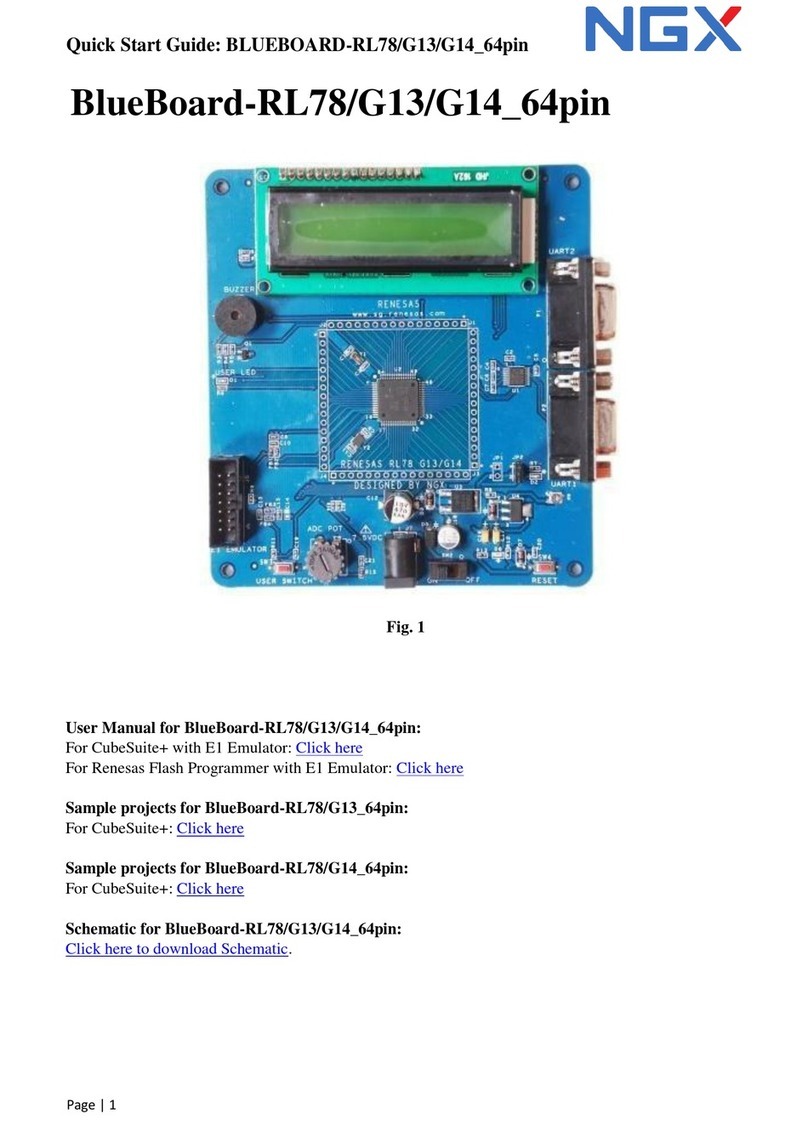
NGX Technologies
NGX Technologies BlueBoard-RL78/G13/G14_64pin Operating and maintenance instructions
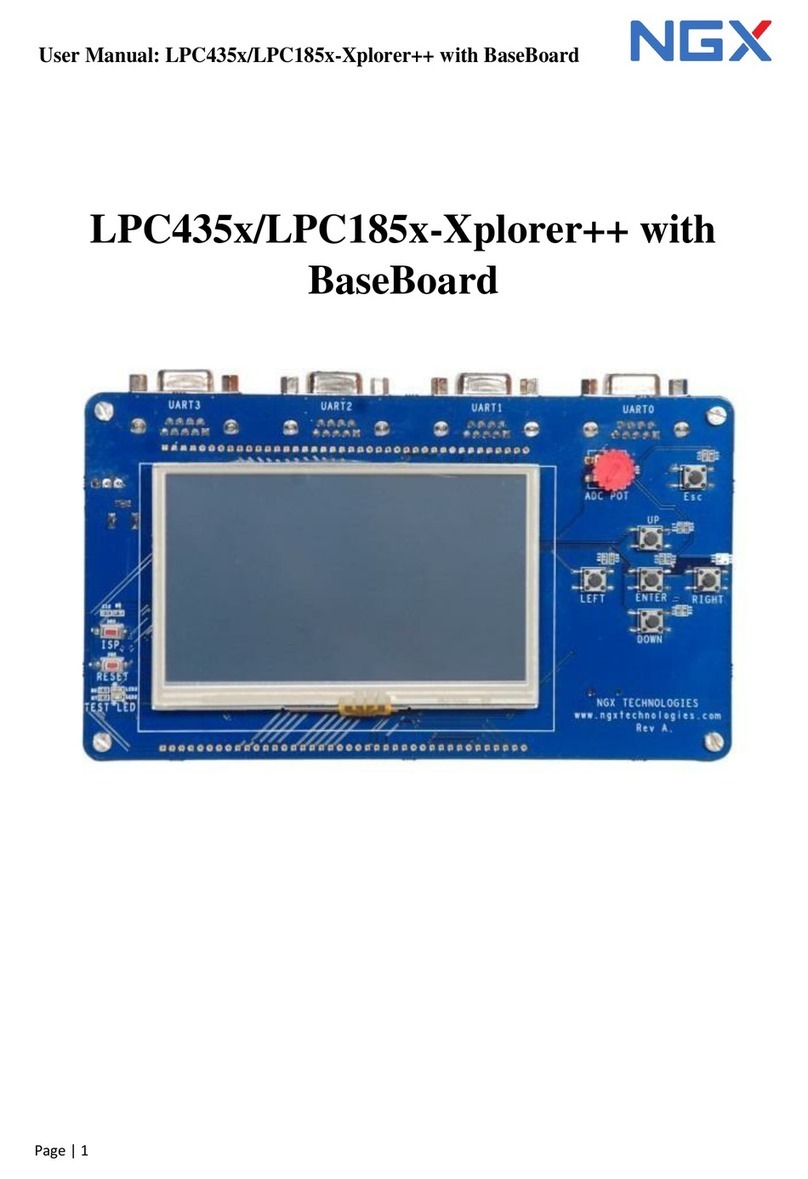
NGX Technologies
NGX Technologies LPC435x User manual
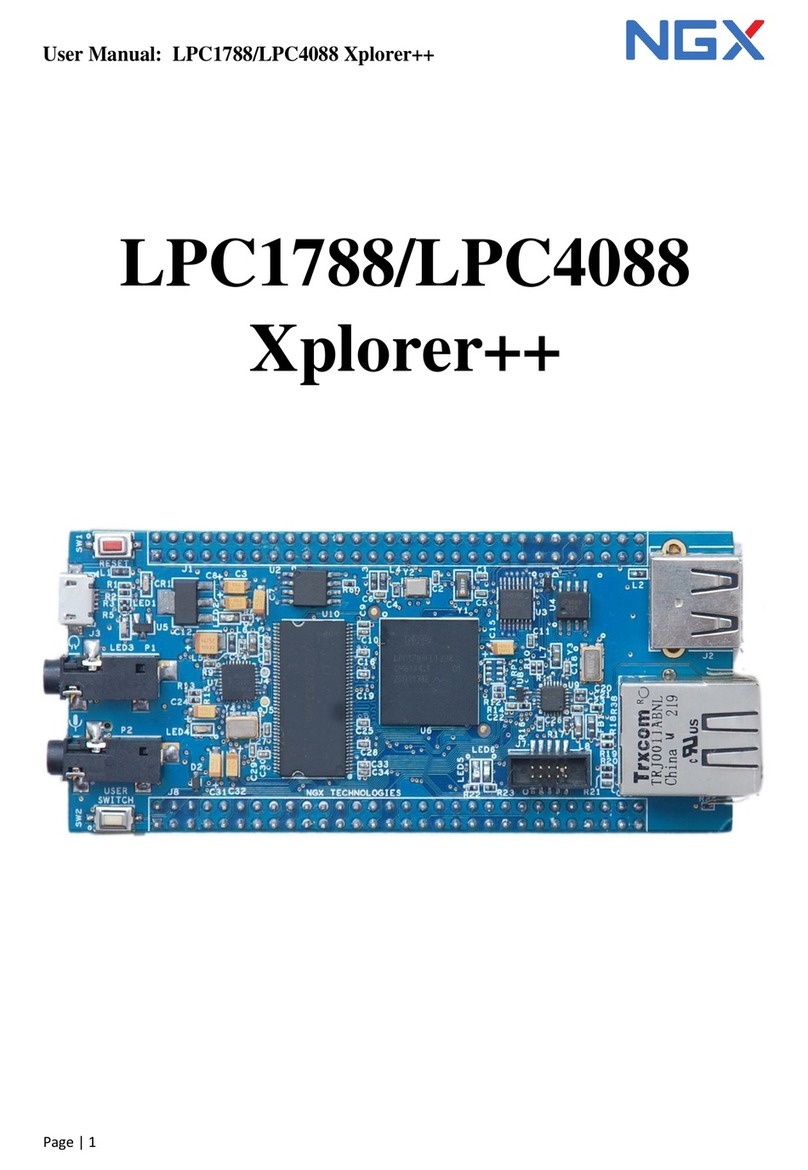
NGX Technologies
NGX Technologies LPC1788 Xplorer++ User manual
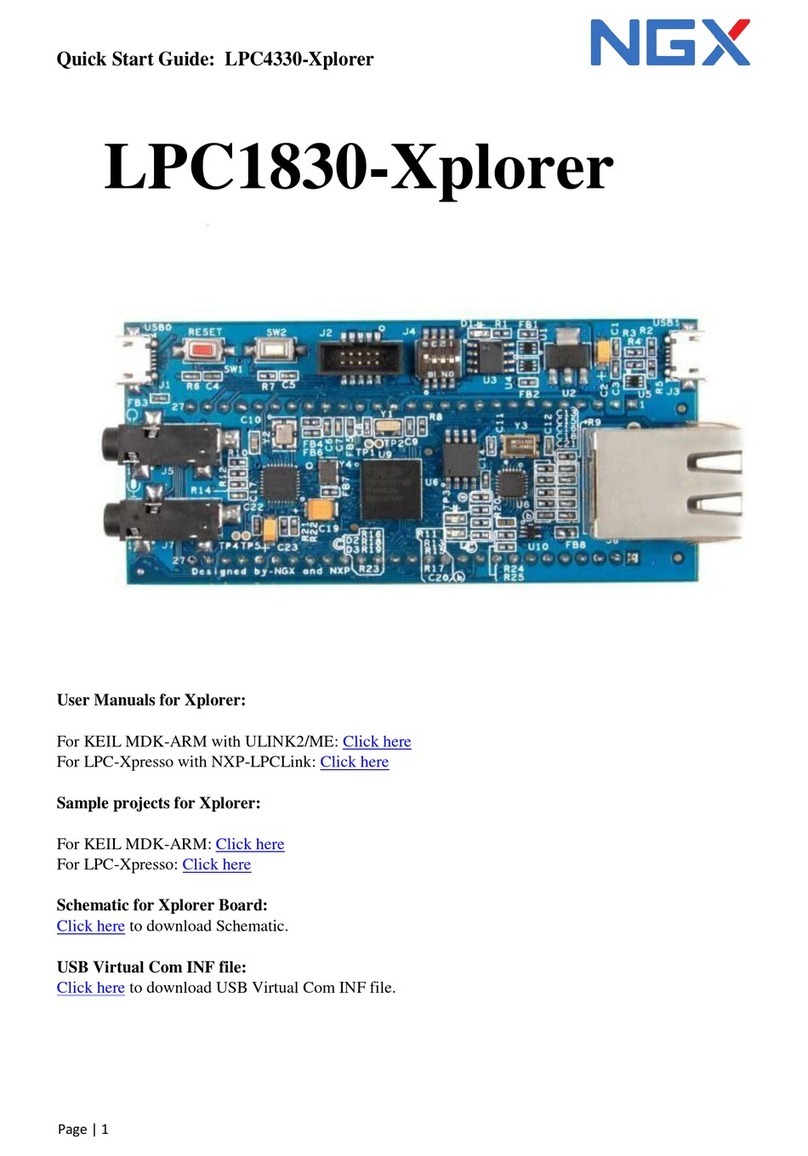
NGX Technologies
NGX Technologies LPC1830-Xplorer User manual
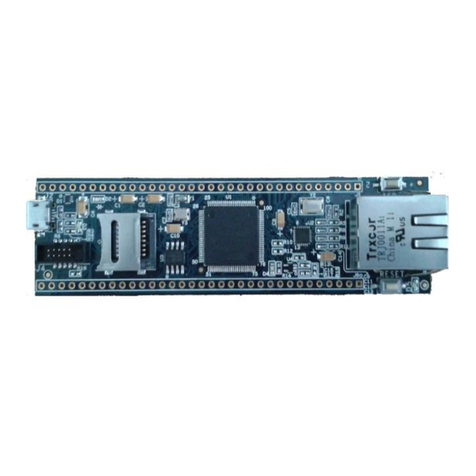
NGX Technologies
NGX Technologies LPC1768-Xplorer User manual
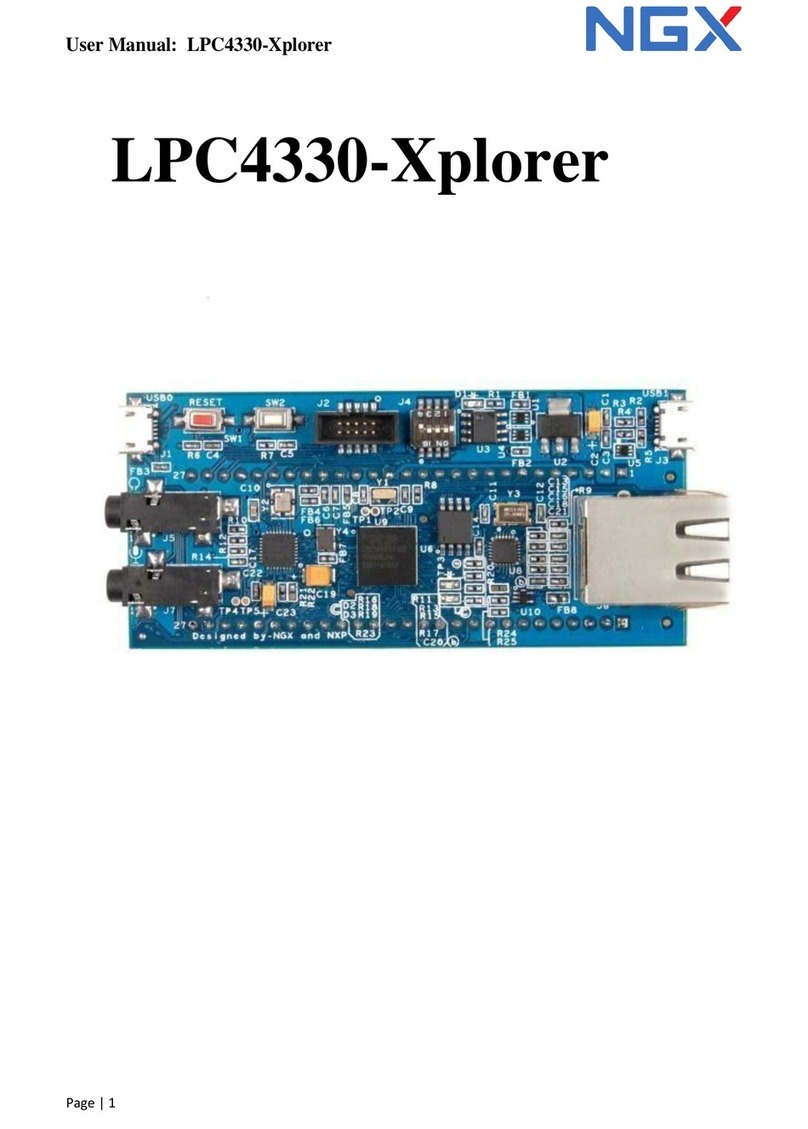
NGX Technologies
NGX Technologies LPC4330-Xplorer User manual
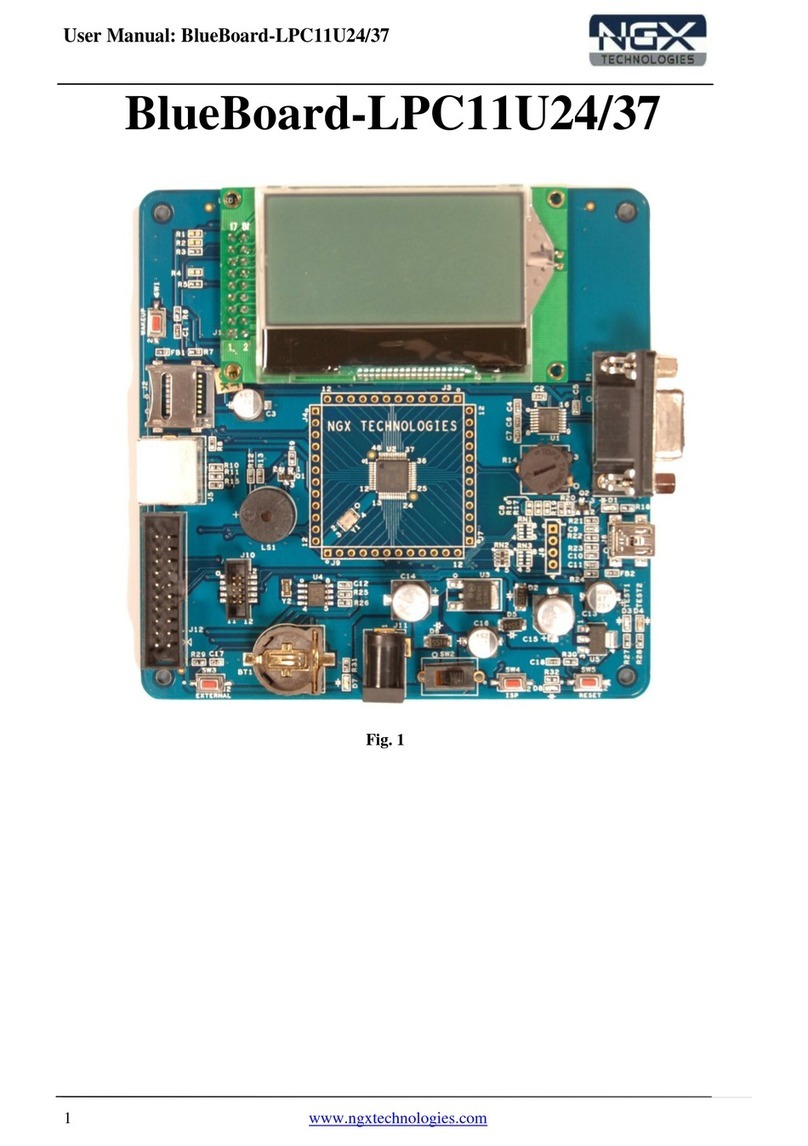
NGX Technologies
NGX Technologies BlueBoard-LPC11U24/37 User manual
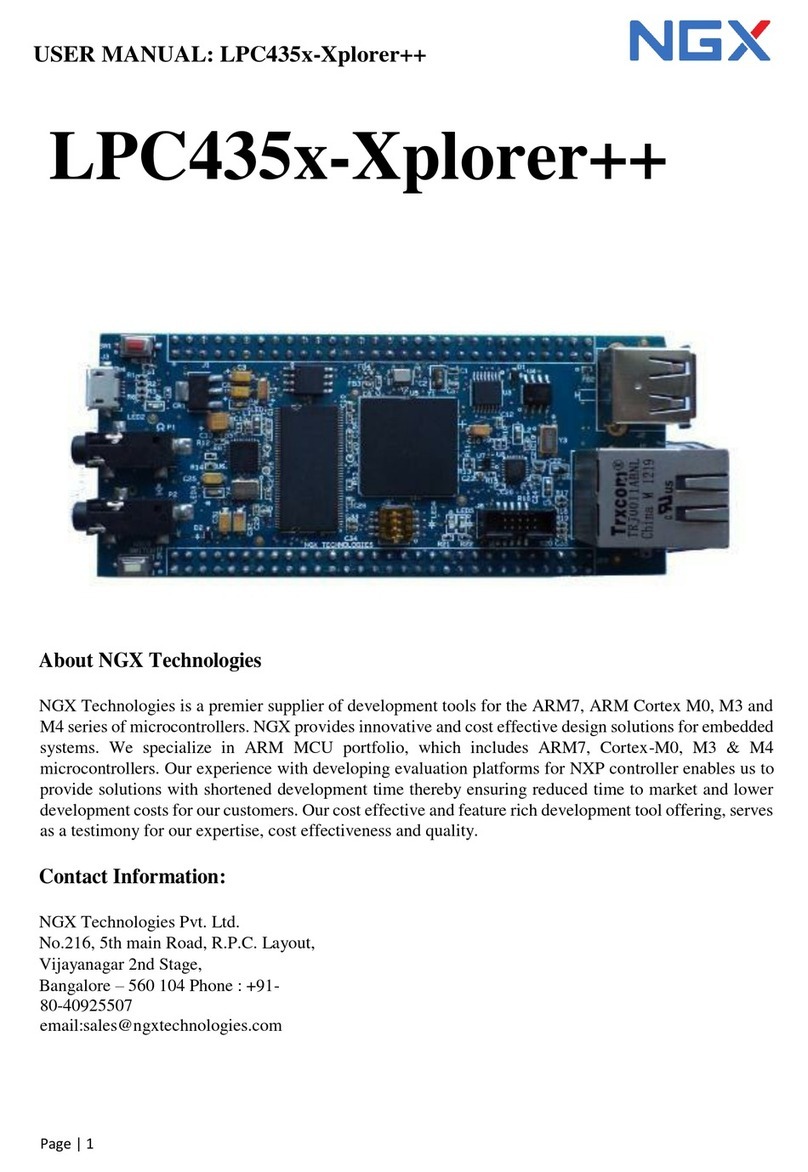
NGX Technologies
NGX Technologies LPC435x-Xplorer++ User manual
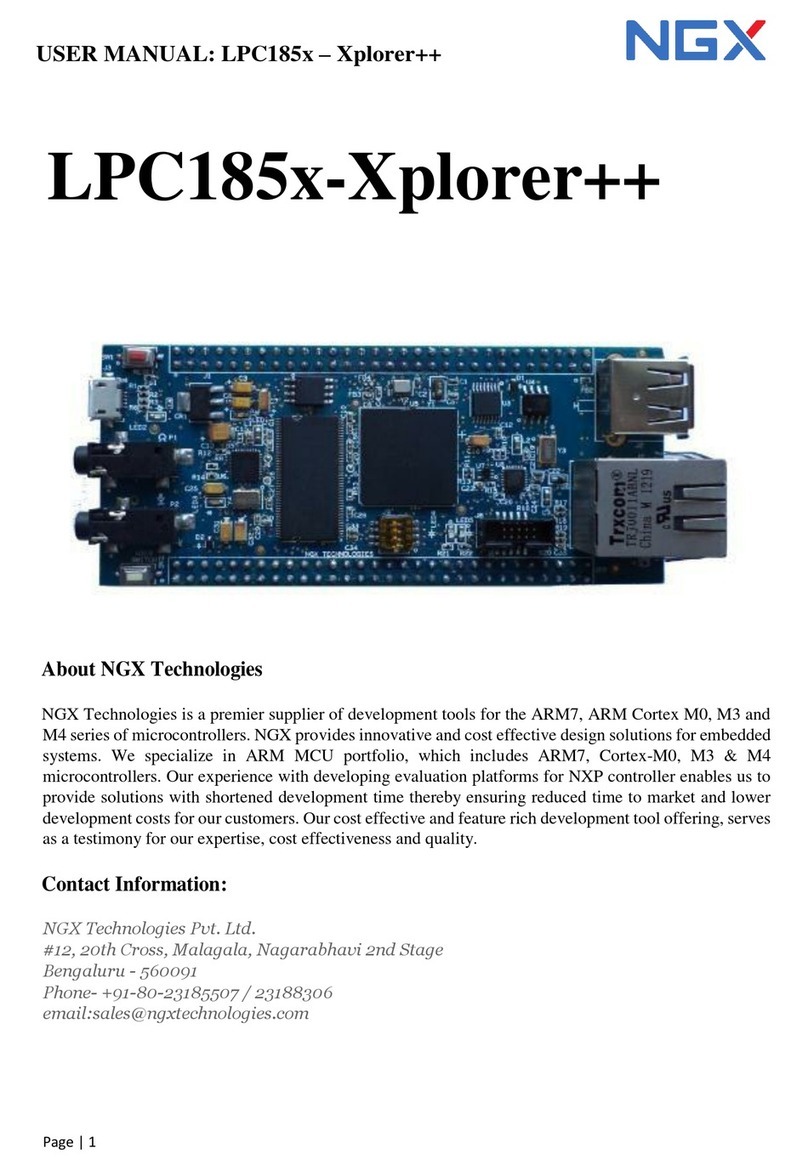
NGX Technologies
NGX Technologies LPC185X-Xplorer++ User manual

